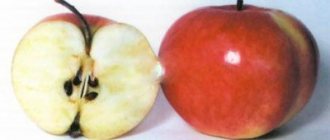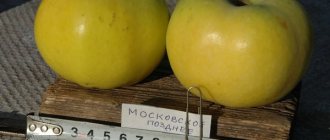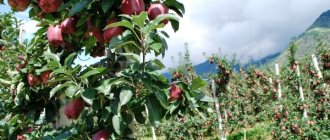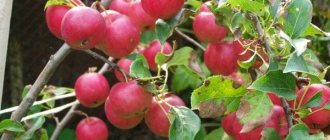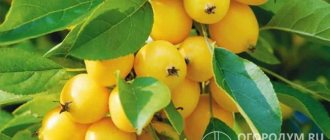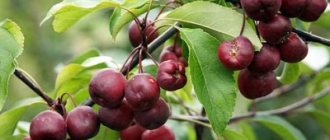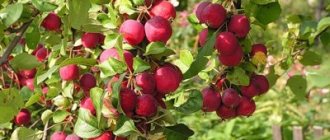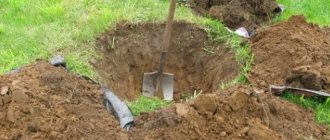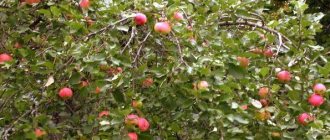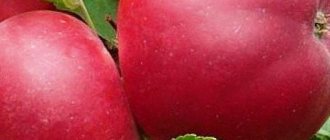- Harvest and storage
The Bellefleur-Chinese apple tree is a well-known late-autumn variety selected by I.V. Michurin, bred at the beginning of the twentieth century. Its main advantage is large marketable fruits with a delicious dessert taste. The apple tree is distinguished by its productivity and moderate resistance to frost, so it still enjoys well-deserved popularity among amateur gardeners.
Apples of the "Bellefleur-Chinese" variety do not fall off the tree during the ripening process and retain their aroma throughout the entire shelf life
We suggest that you familiarize yourself in more detail with the description of the Bellefleur-Chinese apple tree and reviews of gardeners about it. The main characteristics of the variety are given in the table:
| Parameter | Characteristic |
| Culture | Apple tree (Malus domestica Borch.) |
| Variety | "Bellefleur-Chinese" |
| Tree height | Vigorous: from 6-8 to 10 m |
| Precociousness | Low: 8-9 years after planting |
| Terms of removable (technical) maturity | End of August – 2-3rd decade of September |
| Period of consumption/shelf life of fruits | Late autumn; apples are stored for about two months (until early December), in the refrigerator - until January |
| Type of fruiting | Mixed: fruits are set on fruit twigs and last year's growths |
| Productivity of an adult tree | 50-70 kg. Fruiting is annual, as the tree matures it becomes slightly periodic |
| Size and weight of fruits | Medium size or large (from 120 to 300 g), rarely - up to 500 g |
| Shape and color | The fruits are round-oval in shape, with narrow, weakly defined ribs in the upper part. The main color at the time of harvesting ripeness is light yellow; as consumer ripeness is reached, the skin turns white. The outer color on the smaller part of the fruit is expressed as a crimson-red striped blush on a blurred pink background. The skin is strong, shiny, there are no subcutaneous points |
| Fruit pulp | White, fine-grained, tender, juicy and very aromatic |
| Tasting assessment (taste qualities) | 4.7 points (out of 5) – taste of dessert quality, sweet, with pleasant sourness and spice |
| Purpose of fruits | Dessert (universal) |
| Sustainability | Winter hardiness is average; high susceptibility to scab and fruit rot |
| Year of inclusion in the State Register of the Russian Federation | 1947 |
| Recommended growing region | North Caucasian (6) |
| Originator | Federal State Budgetary Institution "Federal Scientific Center named after I.V. Michurin" (Michurinsk, Tambov region) |
Bellefleur Chinese
- This variety is very old. Since 1908, he began his journey in the gardens of Russia.
- The first apples were in 1914. On a 7-year-old seedling.
- This is an outstanding result of I.V. Michurin himself . And he crossed a large-fruited Chinese female with a yellow Bellefleur. The result is a variety suitable for growing in harsh Russian conditions.
- His popularity went off scale: Central Black Earth Region, Northern Caucasus, Ukraine, Armenia. And the Lower Volga.
- variety . For the middle band. For more southern regions it is already late summer.
- Light brown shoots have a slightly reddish tint. Pointed downwards.
- Oval and large greenish-gray wrinkled, almost curled leaves. With jagged edges. They grow from the branch at almost a right angle.
- Large, slightly flattened, ribbed fruits – 200-300 grams. Michurin himself has 340 grams.
Important! There are also very large ones - more than half a kilo! This is on young apple trees.
Fruits of the Bellefleur Chinese apple tree.
- The stalk is medium, even small. The funnel may be rusty.
- The light green surface of apples becomes lighter as they ripen. Almost half of it is covered with pink-red blush. Subcutaneous light dots are clearly visible.
- Very juicy white fine-grained pulp . In sweet and sour apples, the characteristic spicy flavor of the variety is clearly felt. Only a little bit of acid.
The productivity of the Bellefleur apple tree is 50-70 kg per tree.
Caring for young apple trees
At first, until the roots take root, the young tree needs watering every week - at least a bucket per seedling. In the future, watering is carried out as necessary, preventing the soil from drying out.
Immediately after planting, the central shoot of a one-year-old apple tree seedling is shortened by 1/3, and the side branches of a two-year-old one are shortened. In the future, annual pruning will be required. Don't forget about crop rationing. To do this, pluck out some of the flowers, otherwise the apples will be small.
Feeding should be done several times during the growing season so that the apple trees do not experience nutritional deficiencies. In the spring and until mid-July, the apple tree needs 2-3 times fertilizing with a complete complex fertilizer, preferably in soluble form, to be applied when watering. In the fall, you need to limit yourself to only potassium and phosphorus fertilizers, but additionally mulch the tree trunk circle with humus. Young trees need protection from hares; for this, apple tree trunks are wrapped in any available material that allows air to pass through.
Apple tree White filling requires mandatory treatment against scab. Before buds begin to bloom, copper-containing preparations and fungicides are used. During flowering, it is better to use whey.
Attention! Chemical treatments must be completed no later than a month before fruiting begins.
In the fall, preventive treatment of apple trees is carried out with copper-containing preparations or fungicides, but only after the end of leaf fall. This must be done at positive temperatures.
If you follow all the rules for caring for trees, you are guaranteed a large harvest of tasty and healthy apples.
Apple tree Bellefleur Bashkir
Just the facts:
- It was obtained back in 1938 by pollination of the popular local variety Bashkir handsome with Bellefleur china pollen.
- Authors and creators: R.I. Bolotina, T.A. Mansurov, Kh.N. Fazliakhmetov.
- On trial only since 1991!? Bashkiriion has been known in the gardens since the sixties. With different names.
- Grown in Tatarstan and Bashkortostan.
The fruit of the Bellefleur apple tree reaches 200-300 g.
Characteristics
- A medium-sized tree with a wide spherical crown. Commercial plantings are done at least 7 meters in a row with 10 meter row spacing.
- It tolerates frosts of Bashkiria and Tatarstan successfully. As well as drought.
- The yield is quite decent - 50-70 kg per tree. And if in industrial gardens - over 200 centners per hectare.
- The fruits are slightly smaller than those of the famous parents - 150-200 grams. Slightly oval apples with one-sided blush. Tasty and sweet with a strong aroma. Sugar is 12.7%! It's like there's no acid!
- Popular as a commercial variety.
- Apples collected in September are well preserved until February. Can also withstand transportation.
Very important! The variety is pollinated by pollen from apple trees of the same ripening period. And flowering:
- Bashkir handsome man,
- Antonovka,
- Titovka seedling.
Bellefleur is popular as a commercial variety.
Collection and storage
Bellefleur Chinese women collect apples in September. The fruits do not fall off, which allows you to pick them intact directly from the branches. Store apples in a cellar or basement at temperatures from 0 to 10 ° C and humidity up to 70%. It is advisable to place them separately from vegetables and other fruits so that they do not lose their flavor. In the cold, apples can last until December at most.
It is advisable to store apples in shallow boxes, laid in one layer.
Additional characteristics of Bellefleur Chinese
Advantages and disadvantages
Advantages:
- Very impressive sized fruits. Who will be indifferent to the beautiful apples on the counter, 300 grams each? And the surprised eyes of friends. When you treat yourself to your own apples at home.
- Amazing spicy taste of juicy and sweet apples with a slight sourness. The main advantage.
- They tolerate transportation well.
And now about the disadvantages of this variety:
- Frost resistance is low.
- As well as the ability to resist scab and powdery mildew.
- It begins to bear fruit a little late. Especially in comparison with new varieties on clonal rootstocks. And gardeners now are not known for their patience in waiting for a harvest for a long time. I'm not talking about farmers, for whom the harvest is given almost in the year of planting.
- Productivity also varies by region.
- The impressive size of the tree is not very convenient for care.
Important! All this did not allow this wonderful variety to compete with new varieties of apples.
But let's be objective. After all, not many well-known varieties of apple trees retain their popularity and demand today.
Science and selection do not stand still.
We are witnessing the emergence of new unique varieties:
- Able to withstand prolonged very low temperatures (over 40 degrees below zero).
- Which are not afraid of the most common diseases such as scab and powdery mildew. Some people are generally immune to scab.
- And this with excellent taste and a very attractive appearance.
And take note. Very often, breeders use this variety to create new varieties. Already more than 30.
Among them:
- Autumn joy.
- Cherished.
- Altai velvet.
- Rossoshanskoe August.
- Chosen One.
Grown specifically for exhibitions as a souvenir variety. Visitors to these exhibitions continue to be amazed.
Tree height
The height of the Bellefleur Chinese tree is impressive in its size . Solid. It happens even up to 10 meters! But the Bashkir is medium-sized.
Crown width
A striking example of a tall tree with a wide spherical crown.
Productivity
are different every year . In the south, God himself ordered to grow more of them than in the north:
- And yet, the productivity of young apple trees, even up to 12-15 years old, is low.
- But from the age of 20 it is already 150-200 centners per hectare. True, the apples are already smaller.
Tasting assessment
The weight and size of these apples attract attention. And the memorable spicy taste of juicy apples made them famous.
Sugars 11%, sweet and sour with a noticeable aroma. This is Chinese .
And the Bashkir one is even sweeter - 12.7% sugar .
But experts give only 4.6 out of five. Although, why only.
Winter hardiness
Examine the trees in the garden.
Experts believe that the average resistance to frost did not allow this variety to be as popular and in demand among gardeners as before.
In the central regions, during harsh winters, many trees froze.
Disease resistance
Scab disease occurs during rainy seasons. More fruit. Leaves to a lesser extent.
And who would like apples affected by this disease?
Note! It’s not just that this variety is weak to scab. And to other diseases of apple trees.
Advantages and disadvantages
The undeniable advantages of this variety include:
- excellent commercial and consumer characteristics of the fruit;
- annual fruiting without pronounced periodicity.
But the Bellefleur-Chinese variety also has several disadvantages:
- large dimensions of the tree;
- prone to scab and powdery mildew;
- average winter hardiness;
- late entry into fruiting.
Despite the presence of significant shortcomings, the variety remains in demand in amateur gardening, since apples have a recognizable, very good taste.
Reviews
Lidia Ivanovna I. “No one can say for sure how old the tree in our garden is. But definitely under forty. We call him Bellefleur. And Chinese. And also michurinka. Huge in size. This is after numerous updating trims. The apples are not very large. But very tasty. Every year .
I wouldn't say that he needs any special care. As for all apple trees. And no one is going to clean it up. Although we have plenty of other varieties.
It is advised to vaccinate on a frost-resistant variety. But he winters normally anyway.”
Stepan Alekseevich M. “There are many varieties of apples in our garden. But among the autumn ones, I really like Bellefleur Chinese, which I bought after I came across a photo and description of the variety. With its size and very tasty apples . Especially if they lie down for a while. We have them after White Filling. Enough for juices and jams. They don't last long. But we have enough winter varieties. Somehow I missed treatments for scab. It took 3-4 years to correct the error. There is enough copper sulfate and urea.”
Nadezhda Semenovna P. “Many are unfamiliar with the Belfleur Bashkir apple tree variety. And here it is one of the most common. Well suited for growing in our conditions. Although treatments for diseases are needed. As well as from pests. Sometimes it freezes. But there is a harvest every year. Decent. Somehow I’m not used to weighing. And they are stored well.
After the New Year we still eat them. Good quality . It's just interesting. They were brought out back in the thirties. Were they recommended for cultivation in the nineties?”
Alexander Sergeevich S. “I didn’t plant this variety myself. Got it with the dacha. It turned out to be Bellefleur. And I found out that he was Bashkir much later, I came across a description and photo. There were thoughts of replacing it with new varieties. But the hand does not rise to remove it. I’ll try to vaccinate... And we’ll see. But I have a greater desire to instill not Bashkir, but Chinese.
The size of this Michurin variety is very attractive. It's not for nothing that he has been so popular . And over such a vast territory.
And we can work on disease resistance. It’s not called a souvenir for nothing. And they still take it to exhibitions now.”
Protection from insects and diseases
Before the buds begin to swell, the Bellefleur apple tree should be treated to prevent diseases and pest attacks.
The tree is processed by the following means:
- solution of copper sulfate with a concentration of 1%. For a seedling, 2 liters will be enough. If the apple tree is 5 years old, you will need about 5 liters of product;
- nitrophen solution 5%. From 0.3 to 5 liters are used, depending on how old the tree is;
- 0.5 kg of urea is dissolved in 10 water. One apple tree needs about 3 liters of solution.
Further processing is carried out after the buds have finished blooming. But you need to do it before the tree starts to bloom.
The Bellefleur apple tree is treated with the following preparations:
- you need to take 15 liters of water and dissolve 1 kg of copper sulfate in it;
- Bordeaux mixture will also be useful.
The Bellefleur apple tree is more demanding to care for than many other varieties of apple trees. Therefore, it is not so popular among gardeners.
Features of planting and care
Landing
Deadlines
For the middle zone, experts recommend spring planting.
As a rule, this is the second half of April .
This does not exclude planting in the fall:
- After the leaves fall.
- And 15-25 days before the onset of frost.
Advice! The condition of the soil and specific weather will tell you the exact planting time.
Technology
The planting process for this variety is typical for planting an apple tree. All its stages:
- Choose a landing spot:
- Light soil. Loamy and sandy loam soils.
- The place is sunny and well ventilated. Take this into account to prevent fungal diseases.
Carefully! The soil is not suitable for planting:
- Clayey.
- Peat.
- With high groundwater.
- Select the seedling very carefully:
- Only in reputable nurseries.
- Preference for two year olds.
- With a good root system: No damage.
- With live and moist roots.
Don't let the roots dry out:
- Wrap in damp cloth.
- Place in bags with wet sawdust.
- Dig in if you don’t plant right away..
- Before planting, dip in clay mash.
- There are many advantages when purchasing seedlings with a closed root system. Convenient. True, it's more expensive.
- Prepare the planting hole . Prepare it in advance:
- For spring plantings in autumn.
- In autumn 2-3 weeks before planting.
Stages of planting a seedling.
The soil is not always ideal for planting . But you can create a microclimate for the seedling in the planting hole:
- Add organic fertilizers (compost, humus, ash) and mineral fertilizers (superphosphate) into the planting holes.
- The size of the holes depends on the root system. As a rule, it is 80-120 cm in diameter and 60-80 cm in depth. And there may be more. The soil will tell you. Fertile soil should be at least half the volume.
- Sand and peat must also be added to clayey ones. In sandy ones - clay.
- Plant a seedling.
- Add 2-3 buckets of water.
- Mulch.
Please note when boarding:
- The root collar should be 4-7 cm above ground level. This is after the soil has settled.
- Place a stake in the hole and tie up the seedling.
Distance
Keep the distance according to your conditions. But not less than 4-6 meters. And don’t think that they are planted very far from each other.
Advice! And closer to 45-50 meters. To pollinate well.
Features of cultivation
Some disadvantages of the variety will tell you. And don't forget about pollination.
Pollinators for the variety Brown Striped, Autumn Striped, Antonovka ordinary. Pepin saffron and Slavyanka are also suitable.
Agricultural technology
It can significantly influence not only the fruiting of apple trees of this variety. But increase its resistance to diseases.
Tolerate low temperatures without serious consequences:
- Pay more attention to disease prevention : Use copper-containing fungicides (Bordeaux mixture, copper sulfate, copper oxychloride). And complex drugs.
- But don't forget about pests. There are quite a lot of them. Select and use reliable insecticides.
Planting an apple tree seedling.
Remember! Application of nitrogen fertilizers increases the likelihood of fungal diseases. And potassium and phosphorus can increase stability.
- Prepare your trees well for winter. And so that rodents don’t do any harm.
Pruning and crown formation
The most important technique in the prevention of fungal diseases :
- Start doing it at 2-3 years of age.
- Apply in early spring before sap flow begins.
- Remove dry, damaged and duplicate branches.
- Choose sparse crown shapes. To ensure ventilation and good access to sunlight.
- Carry out these works with clean and sharp tools .
- Treat saw cuts with garden varnish . You can also use oil paints.
Breeding methods
Plant frost-resistant varieties (except Antonovka) on apple trees. This doesn't fit! And better in the crown . This will allow you to neutralize or minimize some of the variety's weaknesses and disadvantages.
But they are also grown from seeds. And very successfully.
China Bellefleur apple tree: variety description, photo, planting, when to collect and reviews
Among the apple varieties there are those that are known to almost every gardener. One of them is the Chinese Bellefleur apple tree. This is an old variety that used to be often found in the gardens of the Central regions. It has become popular due to its simple cultivation techniques and good quality fruits.
Description of the Chinese Bellefleur apple variety with photo
The description and characteristics of the Belfleur Chinese variety will help gardeners understand what the apple tree and its fruits look like and what they taste like. Information about this is necessary to decide whether to choose a tree to grow in your garden or not.
History of selection
The author of Bellefleur-Chinese is the world-famous Russian breeder I.V. Michurin; the breeding work was carried out in 1908-1921. The parent forms are the American variety Bellefleur yellow and Kitayka large-fruited. It was included in the State Register in 1947 and zoned in the North Caucasus region.
Appearance of fruit and tree
The Bellefleur Chinese apple tree is tall and powerful. Dense rounded or widely rounded crown. The bark is brown, with a reddish tint; the leaves are dark green with a grayish tint. The apple tree bears fruit on fruit twigs and last year's growths.
The size of the fruits is above average or large, the average weight is 190 g (maximum 500-600 g). Apples are round and oval-round, with a ribbed surface. The funnel is free of rust. The skin of the fruit is light yellow, with striped and speckled blush on one side.
The Bellefleur Chinese apple tree on a semi-dwarf rootstock has a height of approximately 3 m, which makes tree care and harvesting easier. More plants can be placed per unit area, and the total volume of the harvested crop will be higher. The fruits ripen 2 weeks earlier.
The ripe fruits of Bellefleur Chinese look like early Striefel
Lifespan
The maximum age of an apple tree as a species can reach 100 years, but in practice such specimens are rare. Basically, fruit trees live 50-60 years, fruiting time is 20-40 years.
Taste
Bellefleur Chinese fruits are used for dessert purposes; their pulp is fine-grained, white, and juicy. The taste was noted by tasters as very good, sour-sweet, winey, with spicy notes, there is an aroma.
Frost resistance
Winter hardiness is average. In the central zone and northern regions, the apple tree can freeze out in frosty winters, and in damp winters it can be affected by fungus.
Resistance to diseases and pests
The variety is not resistant to scab, leaf damage is moderate, fruit damage is severe. Rot resistance is good.
Flowering period
The Bellefleur Chinese apple tree blooms in late April or May. Flowering, depending on the weather, lasts approximately 1-1.5 weeks.
When to pick Chinese Bellefleur apples
Fruit ripening time is the second half of September. Fruiting is abundant. After ripening, the fruits usually do not fall off and adhere well to the branches. It is recommended to keep them for 2-3 weeks before using them. During storage, the skin of Bellefleur Chinese apples turns white.
Pollinators
The variety is self-fertile and does not require pollinators. According to breeders, it itself can be a good pollinator.
Transportation and keeping quality
The transportability of the fruits is high; they can be transported for storage or for sale. Apples do not last long - only 1-1.5 months.
Features of cultivation in the regions
When bred, Bellefleur Chinese was intended for cultivation in the Middle Zone and southern regions. In the Russian Federation, the variety is distributed in the Central Black Earth Region, the Northern Caucasus, and the Lower Volga region. Apple trees are also grown in Ukraine, Belarus, and Armenia. They are usually found in private gardens; they are used for industrial cultivation in the North Caucasus.
In the southern regions, the variety is considered a late summer variety, its fruits ripen at the end of summer, in the central zone - autumn, since the apples ripen at the end of September.
Advantages and disadvantages
The Bellefleur Kitayka variety has both advantages and disadvantages. The main advantage is the commercial and consumer qualities of apples, the use of the variety for breeding new varieties of the crop, and high drought resistance.
Disadvantages: tall growth, low precocity (begins to bear fruit late, at 6-8 years of age), susceptible to scab.
Ripe apples do not fall off the branches and remain intact and undamaged until harvested.
Planting and care
Bellefleur Chinese seedlings are brought to the site in spring or autumn. The preparation of the plant and the sequence of work are standard: the dried ends of the roots are cut off from the apple tree, and the roots are dipped into a solution of a root formation stimulator for 1 day.
For planting, you need to choose a warm spring or autumn day. First, it is important to prepare a planting hole measuring at least 0.5 by 0.5 m. If the root system of the seedling is larger, then the hole must be made wider and deeper.
Place a drainage layer of broken brick, slate, and small stones on the bottom. Sprinkle a layer of fertile soil mixture on top, consisting of dug up soil and humus (50 to 50), add 1-2 kg of wood ash.
Mix everything.
Landing sequence:
- Place a seedling in the middle of the hole.
- Spread the roots so that they spread freely in all directions.
- Cover with soil.
- Pour water when it is absorbed, lay a layer of mulching material on top, for example, straw, old hay, sawdust.
- Place a peg nearby and tie the trunk to it. This is necessary so that the plant grows straight until it takes root.
Attention! If you need to plant several Chinese Bellefleur trees, the distance between them should be at least 4 m in a row and the same amount between rows.
Caring for an apple tree includes watering, fertilizing, pruning and spraying against diseases and pests.
The frequency of watering in the first month after planting is approximately once a week, but may be more or less, depending on the weather. You need to ensure that the soil always remains moist, not dry, but not soggy.
When the Bellefleur Chinese tree takes root (after 1.5 months), it will be enough to water it several times a season when the ground dries out.
https://www.youtube.com/watch?v=x7ZEUUHxNyA
The first feeding of the apple tree is carried out in the 2nd year after planting, in the spring after the snow melts. Humus is added to the tree trunk circle in the amount of 1.5 buckets per plant and 1-2 kg of ash. Adult fruit-bearing apple trees need to be fertilized at least 2 more times per season - after flowering and in the middle of the period of fruit formation. You can use complex mineral fertilizers or organic matter.
The first pruning is carried out the following spring after planting. The central and side shoots of the tree are shortened, this stimulates the growth of new branches. In the future, pruning is carried out once a year, in the fall after leaf fall or in the spring before the buds swell. Remove all shrunken, frozen and damaged branches, excess shoots that grow inward and thicken the crown.
The incidence of scab can be prevented by preventive treatments with Bordeaux mixture, fungicides, and mandatory pruning. If the disease appears, it must be treated. Among the pests, the Chinese Bellefleur apple tree can be attacked by aphids, spider mites, flower beetles, codling moths, and sawflies. Control measures include spraying with insecticide solutions at the first signs of insect appearance.
Advice! Traditional methods of control will most likely turn out to be ineffective, so there is no need to waste time; it is advisable to immediately use agrochemicals to destroy pests.
Bellefleur Chinese women collect apples in September. The fruits do not fall off, which allows you to pick them intact directly from the branches. Store apples in a cellar or basement at temperatures from 0 to 10 ° C and humidity up to 70%. It is advisable to place them separately from vegetables and other fruits so that they do not lose their flavor. In the cold, apples can last until December at most.
It is advisable to store apples in shallow boxes, laid in one layer.
Conclusion
The Chinese Bellefleur apple tree is an old variety that has not lost its attractiveness for modern gardeners. Despite its shortcomings, it is still popular due to the high quality of its fruit. In a private garden, you can plant an apple tree of this variety on a semi-dwarf rootstock; it has all the valuable characteristics inherent in the variety, but does not grow so tall.
Features of ripening and fruiting
Beginning of fruiting
Be patient. Only from 5-7 years old can you eat apples.
Or even from the age of 8. Therefore, do not rush to replace it with another variety.
Deadlines
Blooms
Like all apple trees, it blooms in May. First half.
Fruit ripening
After the tenth of September the apples are already ripe. For removal for storage.
And somewhere before. And they can stay on the tree for a long time. And don't fall off.
The fruits taste best 10-15 days after being picked from the tree.
Fruit storage
Until the beginning of December, apples retain their great taste. Under special conditions - and until the New Year.
Attention! This variety should be stored separately from other fruits and vegetables. Due to the abundant release of ethylene. You can also ventilate the storage well.
Features of fruiting
Fruits on fruit twigs and last year's shoots. And every year.
And from the age of 20 they have maximum output.
Minor periodicity appears quite rarely with age.
From the age of 20, the Bellefleur apple tree has maximum yield.
Commercial and consumer qualities of fruits
The apples are medium or large in size, round-oval in shape, with slight ribbing in the upper part. The weight of the fruit from an adult tree is usually 200-220 g, from a young tree - up to 300 g . In some cases, the weight of one apple can exceed 500-600 g . Many gardeners grow Bellefleur Chinese because of their interest in the size of its fruits.
At the All-Union Exhibition of Breeding Achievements in 1934, dedicated to the 80th anniversary of I.V. Michurin, the fruits of “Bellefleur-Chinese” were recognized as the largest and most beautiful
The main color of the skin at the time of ripeness of the fruit is light yellow, sometimes with a green tint. As the apples ripen, it turns white. The top color consists of streaks of carmine color over a diffuse light pink blush on the smaller part of the fruit.
The funnel is narrow and deep, sometimes partially rusty, the stalk is short. The saucer is wide, with smooth walls. The cup is small and closed.
The external attractiveness of the fruit is rated 4.7 points (out of 5)
The pulp is white, juicy, fine-grained, aromatic, with a pleasant sweet taste and light spicy sourness. Professional tasters of the State Register highly rated the taste of apples at 4.7 points out of 5 . The fruits are of dessert quality, so they are primarily eaten fresh or used for preparing fruit salads, baking fillings, jam, and compotes.
According to biochemical analysis, the pulp of fruits grown in the Oryol region contains:
| Nutrients and beneficial substances | Quantity per 100 g of product |
| Vitamin C (ascorbic acid) | 7-8 mg |
| Sahara | 11.2 g |
| Acids | 0.7 g |
The excellent taste of Bellefleur-Chinese apples is determined by the relatively high content of sugars and low acids. The sugar acid index (SAI) is 16, which indicates their perfectly balanced ratio.
Harvest and storage
The harvest period depends on the climatic characteristics of the region where the apple tree is grown and occurs at the end of August in the southern regions or the second or third ten days of September in areas with a cooler climate.
During the ripening process, apples do not fall off the branches and hang firmly on them until harvesting, despite their large size and weight
The fruits reach consumer ripeness approximately 15-20 days after harvest. They need to sit for a bit so that the taste becomes more balanced and develops fully.
Apples of this variety cannot boast of high keeping quality: their shelf life usually does not exceed two months (until the beginning of December) . After this, the consumer qualities of the fruit deteriorate - they begin to quickly deteriorate, the pulp becomes mealy.
Apples should be stored in a dry, well-ventilated, dark and cool room, separate from other vegetables and fruits. They need to be sorted and placed in wooden or cardboard boxes, having first wrapped each fruit in paper or layered with straw.
When stored in a refrigerator (at a temperature of 0 ° C), fruits can last until January. Thanks to their durable skin, the fruits tolerate transportation well; even after long-term transportation they do not lose their presentation.
Growing in regions
- Central Black Earth region, North Caucasus, Ukraine, Armenia. In these regions it was zoned. This is earlier.
- Now only in the North Caucasus. But in individual gardens you can also find it in more northern areas.
- In southern areas it is like a summer variety.
Moscow region
Here it is autumn . And the yield is far from the same as in the northern Caucasus. And less sugar.
Experts recommend growing this variety as a graft to make it more frost-resistant.
In the Urals
Here in the gardens of lovers you will meet Bellefleur Bashkir. Often. This is his homeland. And in the regions of Siberia adjacent to the Urals.
What type does it belong to?
Bashkir Bellefleur apples are early winter varieties. Ripe apples have high taste and nutritional properties. Among winter varieties, Bellefleur is considered one of the best. The plant is resistant to frost. In addition, the inflorescences can tolerate spring morning frosts.
See also
What varieties of apple trees are best to plant in the Urals, features of choice and characteristics of the speciesRead
